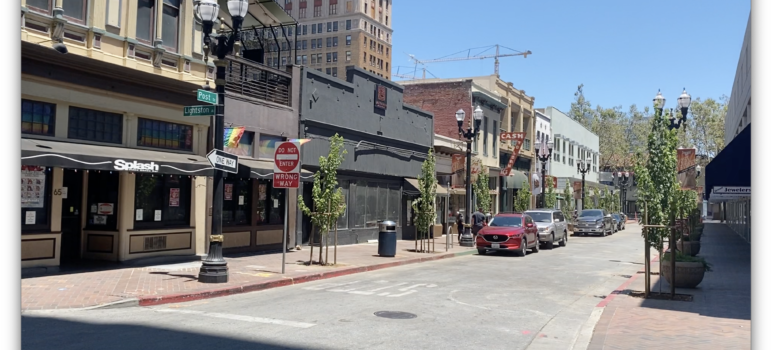San Jose’s LGBTQ+ community will soon have a place to call home in the heart of town.
An effort to create that center—a new district that showcases the history, culture and diversity of the queer community—was announced this week.
Called “Reimagining Post Street,” the project is in its first of four phases that will end in a community-planned LGBTQ+ district on Post Street—a quaint little downtown alley between South First and South Market streets.
Eventually, the area will be known as the “Qmunity” district and will be filled with businesses owned by LGBTQ+ or ally entrepreneurs. The effort is being led by downtown Councilman Raul Peralez and Project MORE President Nathan Svoboda.
“We can boast about a city like San Jose that certainly is large in size although with a small-town feel, but ... we needed our own space here,” Svoboda told San Jose Inside.
Peralez said he agreed as soon as Project MORE brought up the idea several years ago. The District 3 councilman said it aligned with his longstanding efforts to secure city funding to liven up San Jose's downtown street life.
“This was definitely a community led effort, I just did my part,” he said. “I did fully believe in this, I definitely clung to it right away.”
When Qmunity is complete, San Jose will join a handful of U.S. cities with established spaces for the LGBTQ+ community. In California, those include Lavender Heights in Sacramento, the Castro District in San Francisco and West Hollywood.
Svoboda credited his staff and Peralez for getting the ball rolling and being proactive after an initial conversation with other associated individuals and organizations.
Peralez “was instrumental in not only getting necessary city support, but also helping to champion the initial investment funding,” Svoboda said. “That helped because it legitimized the project if you will, and it went from a conversation to actual execution.”
The councilman brought in key figures to the project, including the San Jose Downtown Association and helped secure $65,000 in city funds for the project—money that has gone to environmental improvements for the neighborhood.
SJDA contributed new trees after the old ones on the street were found to be diseased. New programmable LED lights zigzag above the roadway and urban artwork will be added to crosswalks and sidewalks along Post Street. Also on the docket: an LGBTQ+ mural and banners that will represent the identity or brand of the district.
“The other part of the first phase that is not connected to the funding per se, is helping to create a shared vision,” Svoboda said. “The community will help decide how and what will happen, but to begin the process, we need a starting point. So that involves having a shared conversation with the community and stakeholders.”
Project MORE worked with San Francisco-based architectural firm Gensler, which helped create a vision space for the project, including imagery, branding and color palettes. Phase 2 involves a series of town halls with the community.
The discussions will inform a new master plan before setting a budget and seeking out funding to make it all happen. Phase 3 will be putting those plans and money to work.
As the city faces a dramatic budget deficit, it’s unlikely that Peralez will find more funding through the city’s general fund, he said. But he hopes the investments that have already been made will offer “momentum," for the project.
“This unveiling is going to help, and there’s an opportunity of getting other dollars from other organizations now,” Peralez said. “There’s also the opportunity of just building out the area for the LGBTQ community. We’ve been talking to the county around could we have a resource center, a health center on that street because there’s actually a number of vacant businesses there.”
The last phase of the project is about the future and sustainability of Qmunity.
“Phase four has never been verbalized, but it would involve ongoing maintenance, steps to address where do we go next and how does this thing get sustained,” Svoboda said. “This is not just a celebration for the LGBTQ, but also it’s also beneficial for businesses and those who visit the space.”
Janice Bitters also contributed to this report.


Everyone in Real Estate know first come the gays, then comes massive growth in property values. Probably only wise investment I’ve seen out of the city council in a while.
Splash and Mac’s are both awesome spots. Are there other LGBTQ+ businesses on this street?
Oh boy! I’m sorry, I should say, Oh assigned male at birth!
The *real* story here is the failure of the LGBT DeFrank Center’s Executive Director for Life Gabrielle Antolovich to initiate positive change. Long before COVID, their budget has plummeted, full time staff went from about 17 to zero, and programs have limped along. She remains an anachronism bleating about issues that were relevant 50 years ago, but not today. Plenty of straight couples enjoy dancing and socializing at clubs flying rainbow flags. Nobody cares.
DeFrank would have died long ago were it not subsidized by a $1 / year rent from SJ. The good news is that Project More is doing something to boost commercial activity and prosperity that benefits all SJ residents while DeFrank just squanders enormous opportunity costs promoting tribalism.
Imagine my surprise I though The LGBTQ+ Center of San Jose was the Public Rest room at the Corner of Asbury and Irene St’s. Well since normal WOK people in town are moving off to Portland and Seattle
in search of lower taxes. I suppose reoccupying an ally in downtown SJ with a bunch of non breeders makes some sense. Don’t forget to paint the crosswalks and BLM graffiti pink!